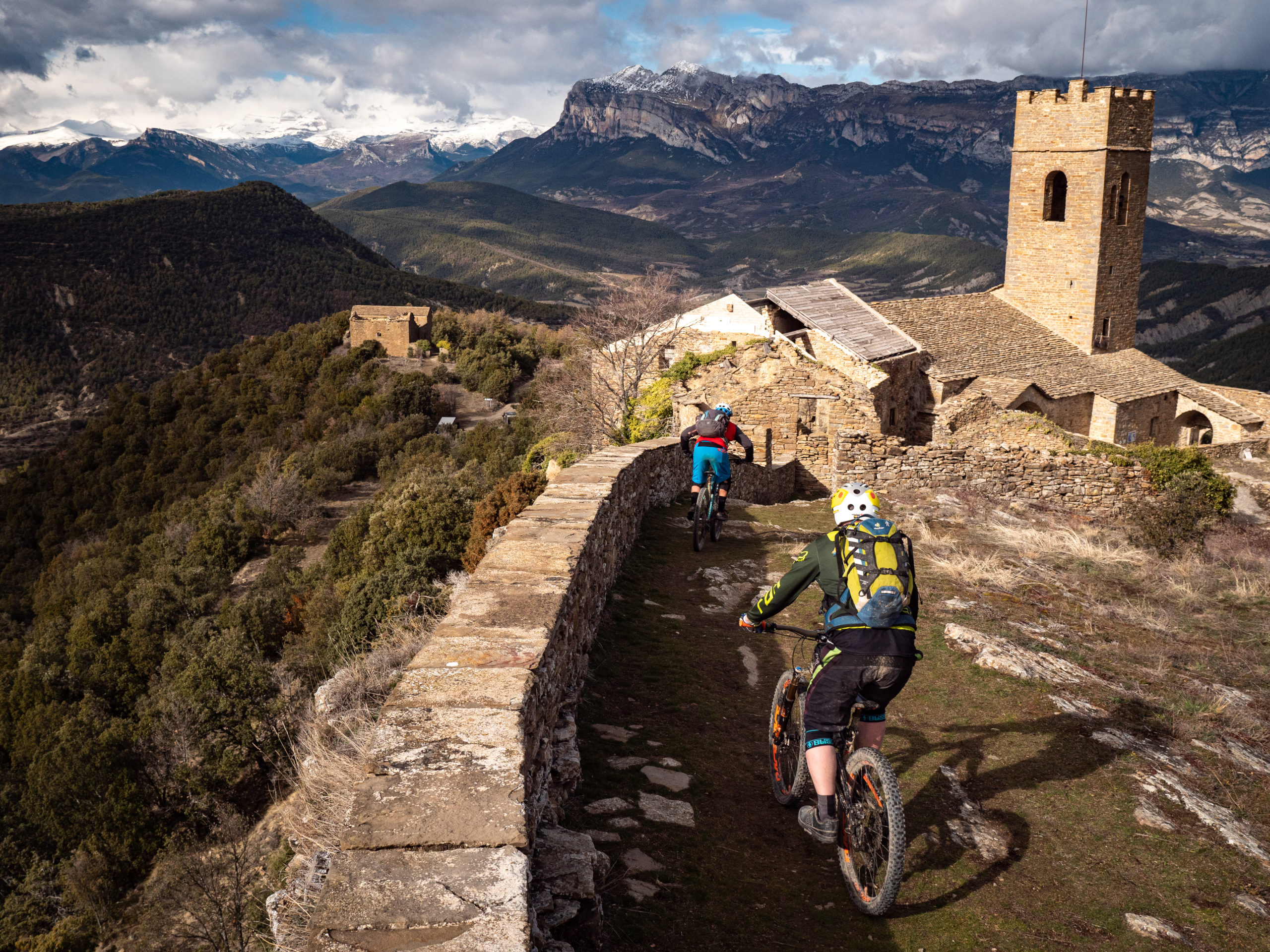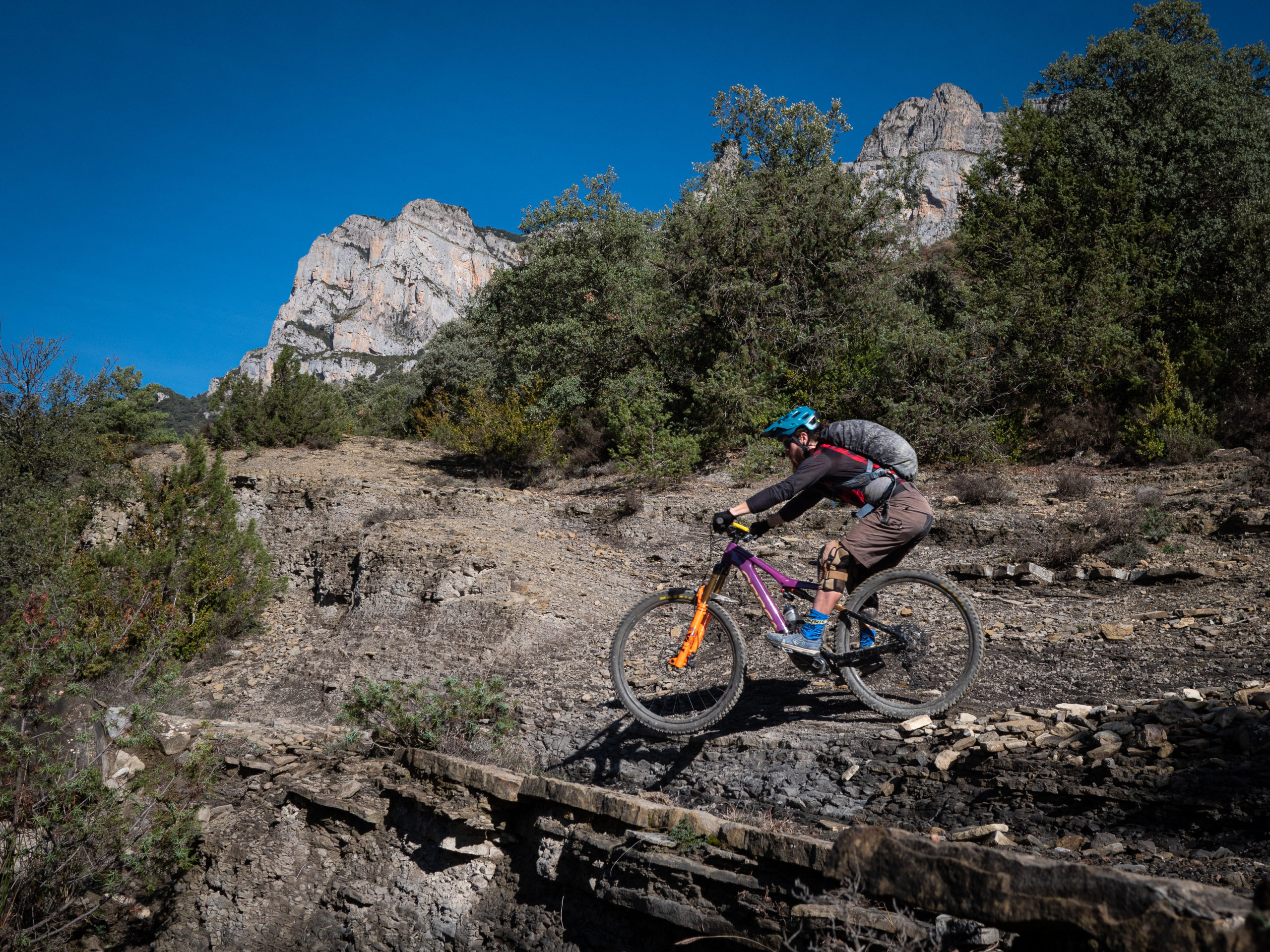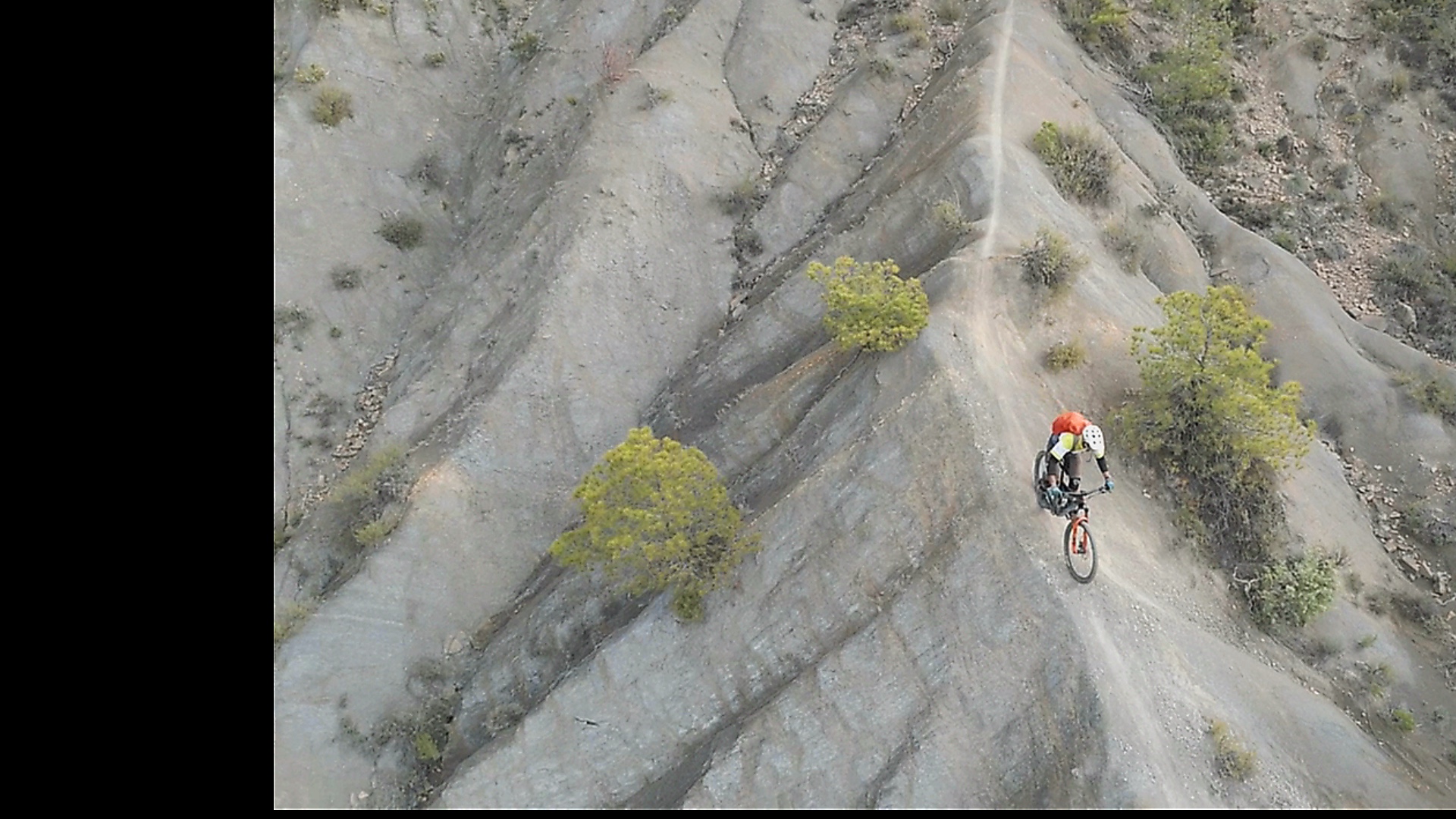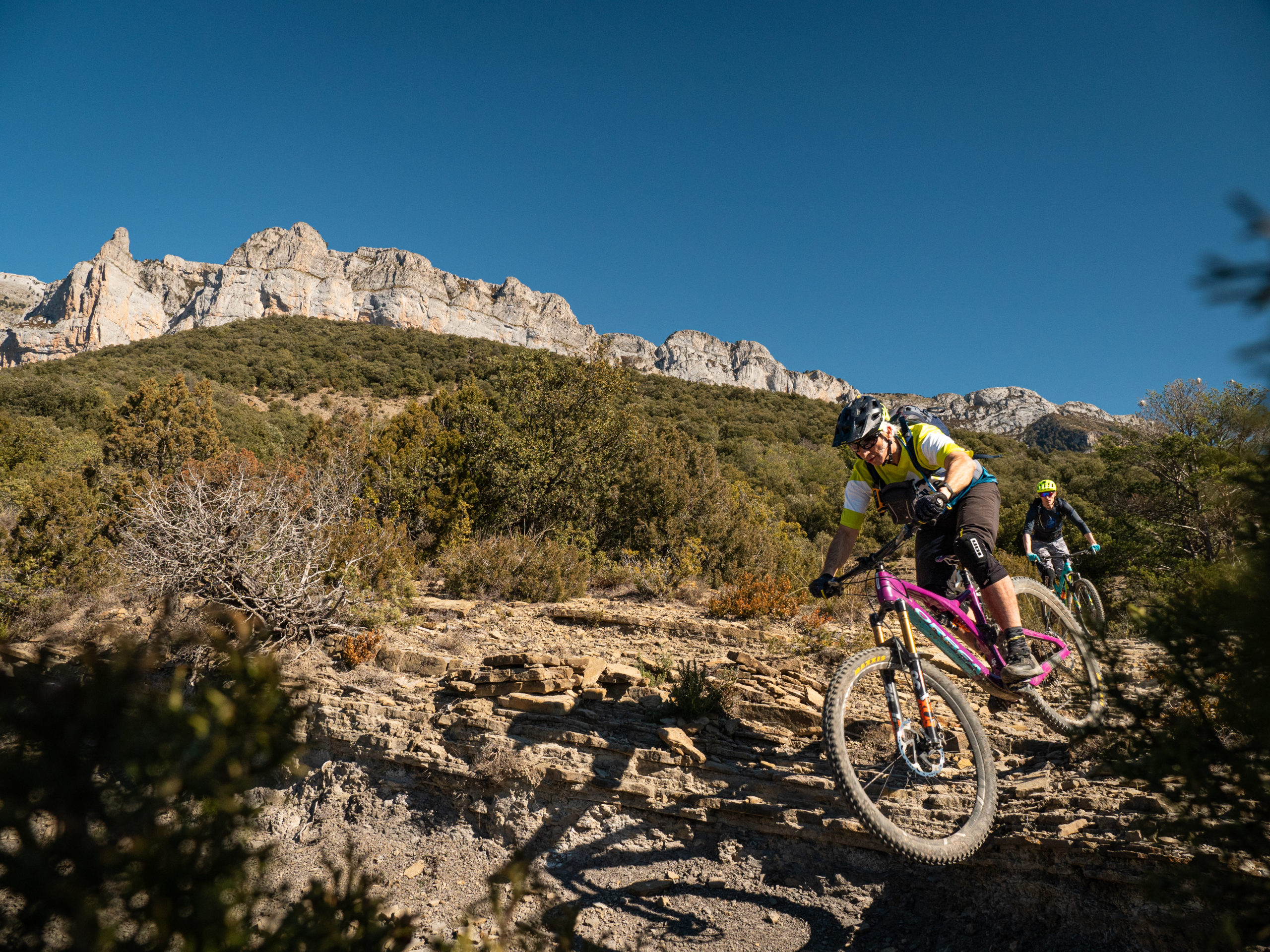You know that mountain bike mecca in Northern Spain, with hundreds of miles of handbuilt trails, and cheap hotels, and a bike shop, and shuttle companies, with the stunning mediaeval castle, friendly locals and almost no rainfall?
Neither did I, until a couple of weeks ago. Welcome to Ainsa – the best MTB destination you’ve never heard of.
Ancient treasure
Ainsa might be the greatest hidden gem in European mountain biking. This tiny, unassuming Spanish town (pop. 2100) rests at 600m up the slopes of the Pre-Pyrenees, about 45 km from the border with France. The surrounding mountains are criss-crossed with dozens of natural trails, running above the two rivers that meet below, with craggy overhangs, plunging chasms and the kind of grippy, rolling rock formations that Moab or British Columbia would be proud of.
It doesn’t have the reputation or facilities of the Alps – no bike parks or chairlifts here. But the sheer quantity of trails and passionate advocacy of the locals have transformed Ainsa into a destination any serious mountain-biker should have on their must-ride list. International YouTubers such as BKXC and McTrail rider have made inspiring content here, the Enduro World Series has hosted races here, and it’s still considerably warmer and drier than the UK in November. So I signed up for a week’s riding, jumped in a hire car at Barcelona, and wound my way north.
Castle in the sky
The skyline of Ainsa is dominated by the Castillo Y Casco – an 11th-century castle and courtyard that sits high above the town, with incredible views of the surrounding hills from its narrow ramparts. The organisers of the Enduro World Series liked the place so much they staged a round here in 2018, complete with an opening stage that saw riders descend the castle steps, tackle a gap jump, hit some temporary berms in the town square and then ride through a local’s house, pausing for a mandatory tequila shot in the living room.
Those racers were also here for the hundreds of miles of trails within riding and shuttling distance of the town. For the last 15 years, a dedicated team of local riders, volunteers and bike industry types have been working non-stop to turn Ainsa into one of Europe’s best locations for MTB, with a healthy side dish of road and gravel loops included for good luck. The Zona Zero trail network now comprises nine separate zones, all packed with hand-built trails that have been mapped, signed and maintained specifically for riders. From Ainsa town itself, there are multiple routes you can ride to without a shuttle, and over 18 trails just a short drive away. Even in late November, our hotel is packed with riders from Spain, Norway, Holland and beyond, not to mention my companions for the week – we have Brits, Germans, Scots, US and Dutch riders all along for the journey.

Scots guard
We’re being shown the adrenalin-pumping delights of the area by Doug McDonald, owner of Basque MTB, a company that’s been running guided riding tours here in Ainsa and beyond for many years. As we wind our way up the mountain roads with a trailer full of bikes clanking at the back, he explains the unique characteristics of the towering hillsides we’re about to start plummeting down.
The Pre-Pyrenees were formed by the tectonic shift that thrust the Pyrenees out of the ground about 65 million years ago. They’re the debris around the base of the Pyrenees proper to the north of here – we’re going to spend the week riding on what used to be the ocean floor, with pebble-sized fossils under our tyres. Even today, geologists bore into the rock to get a core sample that can show them layers of seabed going back millions of years, without the hassle of doing it underwater. The locals roam the hills with shotguns, hunting wild boar. Vultures and eagles fly overhead. As you look around, the signs of modern civilization are few and far between. Welcome to the wild country.
Extra-Worrying Steepness
I’m no EWS rider, but from the very first descent of the morning, it’s obvious why they staged a race here. The steep, rock-strewn trails are pure adrenaline baths. Huge slabs sit loose on the trail surface, shifting under the weight of bike and rider, flying up from tyres and threatening our shins and derailleurs from every angle. The switchbacks are tight and unforgiving, with big lumps of stone exactly where you’d prefer your front tyre to be. Most of all, it’s constant. None of the flowy relief between features that you find in bike parks or groomed trail centres, just a relentless barrage of rock gardens, narrow gaps and split-second line choice from top to bottom. I absolutely love it.
It takes time to adjust to it though. The first few minutes, even after a full week of riding, are spent in a mild panic, half-expecting the trail to smooth out so you can get yourself together, followed by the realisation that it’s all like this and you might as well get used to it. With a bit of confidence, it becomes easier to blast through shoulder-shuddering rocks with something approaching smoothness, and start looking for lines that maximise the flow of the trail without slowing for every lump and ledge. How a racer does this blind, riding flat-out against the clock, remains a mystery to me.
But this kind of knife-edge riding is exactly what I came for. My beloved Sussex trails just don’t have this kind of elevation, steepness and rocky terrain, so being here forces me to change my riding style. These trails require constant and total focus, with a much bigger reliance on the combination of momentum, body position and bike performance needed to rattle down the rocks and roots that cover every trail. I form an instant and lasting respect for the build quality of my 29” wheels and the ability of my suspension to soak up the hundreds of mistakes I feel I’m making every minute, and I’m constantly astounded not to have been hurled over the bars by some evil, pedal-clutching rock every time I make it to the bottom.

Droning on
Doug, with an ever-watchful eye on attracting future riders, deems a particular section of descent worthy of capturing on drone video, and asks us all to stop at the top while he makes ready. Hanging around at the start of a scary trail feature never does much for my confidence – the body starts to get cold, you can’t resist peeking at what you’re about to ride down, and it’s hard not to over-think the whole thing. But pictures or it didn’t happen, right?
When that feature is a thin ridge, which plunges steeply down on either side, with a track no wider than a foot to carry the wary rider up and down a series of abrupt whoops as it descends to the forest floor, that anxiety is magnified. It’s one of those sections that has a thousand ways to get it wrong and only one way to get it right. A drone crash does little to steady our nerves, and even after the first couple of riders make it down, their waves of encouragement seem to come from a place so far down the mountain that it’s impossible to think we’ll get there in just a few seconds.
For all my dithering, It’s a moment of perfection. As I roll up and down the skatepark-like mounds of rock, with the humming drone off to the left, I get the holy grail feeling – I’m doing my best riding, on a fantastic trail, with movement, landscape, bike and technique all bound into one inseparable rush. What a place this is.

No escape
It’s inevitable – by the fifth day of climbing, descending and wrestling bikes over streams and rock slabs, collective tiredness starts to claim its victims. I get off lightly with a lucky (if slightly humiliating) scrape across my left arse cheek after slithering to the ground in a steep, slimy chute. Others aren’t so lucky. Nick from Surrey washes out his front wheel and ends up with a sprained wrist, Jeff from San Diego slides down a rock face into the river, and Mark from the Netherlands takes a jutting stone slab to the hand. Thankfully it’s nothing too serious – Ibuprofen plus some good-natured ribbing sees most of us back in the saddle – but it’s a good sign. This landscape makes everyone want to ride as hard and fast as they can.
Old Man River
There’s a trick I try to use when I feel myself getting tired or frustrated on a ride, particularly when I’m somewhere as stunning as Ainsa – I just tell myself to look up, take in the landscape and remember how lucky I am. It’s particularly effective here – even my whinging brain is awed into submission by the moody granite-coloured rock faces, wild green pine trees and layers of mist and cloud that drift in and around us as we traverse the mountain paths. One climb sees us winching our way up undulating rock as the sunlight pokes its rays through the trees and the mist, as vultures swoop over the canyon below. Another afternoon, we spent an hour slowly descending back to the shuttle vans along a trickling river bed – riding up the steep walls of its turns, sliding over wet staircases of rock, trying to hop and swerve the speed-sucking sands and gravel beds. As I look up and see the train of riders stretched in front of me, it feels like nothing so much as an MTB western – a momentous journey through the elements towards some epic goal. Until I fall into a puddle.
But no amount of dampness, or leg pain, or rock-smacked shin can temper the impact this landscape and its riding has on everyone here. Our guides – most of whom have been riding here every day for the last two months – still come off every trail with huge grins on their faces, joining in with our adrenalised babbling as if they’ve just ridden it for the first time. We’ve fallen head over heels in love with these trails.

If you build them…
Ainsa doesn’t have the groomed berms of a UK trail centre, or the luxury of an Alpine chairlift system. It’s not as glamorous or as well-appointed as Whistler, or as iconic as Moab. It’s a bit more of a journey to get here. But the rewards for those who make the journey are almost endless. There’s more trails here, for every standard of rider from newbie to pro, than you could ride in a month. The hotels and Airbnbs welcome muddy, starving riders with open arms – there’s a bike washes and storage in our hotel, tools for repairs in the basement and trail maps on the walls. It’s also way cheaper than any of the big-name resorts: a round of three beers and two coffees in a hilltop bar came to €4.20, and a week’s accommodation with breakfast was less than €300.
So if you want more trails than you can count, in a landscape you’ve never seen before, with cheap beer, plentiful food and a ruined 11th-century castle, take a moment before you rush off to Morzine. Consider this buried mountain treasure instead – the rewards are boundless.
Tim would like to thank the good folk at Basque MTB and Privateer bikes for all of their help with his trip.
Make sure to check out our mountain bike insurance, and get a quick quote for your bikes here.
Follow Tim here:
Instagram- @timnwild